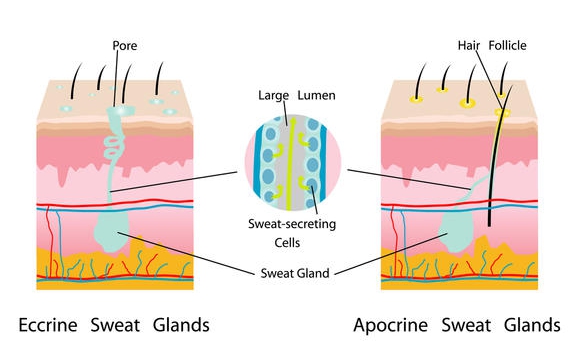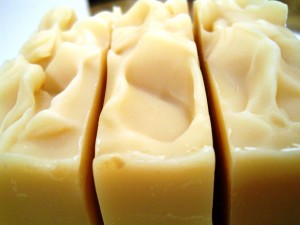science
-
Sweating, Body Odor and Apocrine Glands
Sweat is essential to human survival and serves as the body’s coolant, protecting it from overheating.
There are two to four million sweat glands distributed all over our bodies.
You skin has two main types of sweat glands; Eccrine and Apocrine.
Eccrine sweat glands are far more numerous and occur on virtually all skin surfaces. Sweating on your forehead, back, arms, etc. They become functional shortly after birth and produce a clear, watery, odorless substance in relatively large amounts to cool the body when overheated.
Apocrine sweat glands, larger than eccrine glannds, occur only in the armpits and pubic area, and around the nipples and navel. They do not become active until puberty and secrete small amounts of a milky, thick substance that is rich in fats.
Although apocrine sweat is odorless when secreted, bacteria normally found on the skin comes in contact with the fats. When this fatty fluid comes in contact with bacteria on the skin’s surface, it produces a characteristic body odor. This is the primary source of body odor arising from both the pubic region and the armpits.
Both the eccrine and apocrine sweat glands are activated by nerves. These nerves respond to a variety of stimuli including:
- - messages from the brain indicating that the body is too hot
- - hormones
- - emotions
- - physical activity or exercise.
In people who have excessive sweating, or hyperhidrosis, the sweat glands (eccrine glands in particular) overreact and are overactive to stimuli, producing more sweat than is necessary.
 Eccrine and Apocrine Glands - How They Work And How Odor Is Created
Eccrine and Apocrine Glands - How They Work And How Odor Is CreatedThe presence of pubic hair in the genital region contributes to body odor emanating from this area for several reasons. While eccrine glands discharge their watery secretions directly onto the skin surface, apocrine glands empty into hair follicles -- as do skin oil glands. The combination of apocrine sweat and skin oil, or sebum, sticks to pubic hairs. Bacteria that feed on these substances also adhere to pubic hairs. Thus, pubic hair provides a physical environment that supports the processes that lead to body odor. The same holds true for armpit hair. People who shave their armpits generally exude less body odor. Similarly, people who trim or remove their pubic hair also usually have less body odor in their pubic area.
Naokeidoe Creations, click to purchase, Natural Deodorant greatly aids in naturally controlling the odor and sweat from the armpit and pubic area in females and males.
-
How does commercial soap compare to Naokeidoe Creations Soap
This comparison chart has been circling the web for many, many years. I first started sharing with it our customers back in 2013 or 2014 that long ago. All of it still holds true today. Do you know what's in your soap and what you're putting on your body? If not, this will help.
HOW DOES COMMERCIAL SOAP COMPARE TO NAOKEIDOE CREATIONS SOAP?
Is your soap really soap or is it detergent? Look at the label on your bar of commercial soap. Is it called "soap" on the label, or is it a “beauty bar,” “cleansing bar,” or “deodorizing bar?” If it does not say "soap" then it is not really soap. Many commercial brands are not called soap because by law they cannot be - they are DETERGENTS. Most products you think of as soap are actually detergents. Detergent is good for one thing--removing oils. Detergent is great when you are cleaning laundry or dishes, but NOT when you are cleaning your skin!
Detergent bars strip the natural moisturizing oils from your skin. So after you take a bath or shower with commercial soap you reach for that bottle of expensive lotion, to put back the moisture that was taken away by the commercial soap.
Detergent is great when you are cleaning laundry or dishes, but NOT when you are cleaning your skin!
The label of ingredients on a bar of commercial soap has a long list of unpronounceable chemicals. Whether or not these synthetic chemical additives are bad for you may be up for debate for some people, but chances are you are better off with none at all. The chart below compares Naokeidoe Creations Handcrafted Soap with a popular brand.

COMPARE FOR YOURSELF
Naokeidoe Essential Oil Soap - Lavender Fields
saponified oils of
olive
coconut
organic palm
castor bean
organic unrefined shea butter
organic natural cocoa butter
organic sunflower
avocado
distilled water
lavender essential oil
kaolin natural clay
organic alkanet root (natural herb that provides purple color)Leading Popular Brand with “1/3 cleansing cream”
sodium cocoyl isethionate (synthetic detergent)
stearic acid (hardener)
sodium tallowate (sodium salt of cow fat)
water sodium isethionate (detergent/emulsifying agent)
coconut acid (the sodium salt of coconut oil)
sodium stearate (emulsifier, also used as a cheap stabilizer in plastics)
sodium dodecylbenzonesulfonate (synthetic detergent, skin irritant) sodium cocoate or sodium palm kernalate(sodium salts of coconut or palm kernel oils)
fragrance (synthetic scent, potential allergen, common skin irritant) sodium chloride (table salt used as a thickener)
titanium dioxide (whitener, also used in house paint)
trisodium EDTA (stabilizer, used in industrial cleaning products to decrease hard water, skin irritant)
trisodium etidronate (preservative, a chemical that is used in soaps to prevent soap scum)
BHT (preservative, common skin irritant)Dove is the bar most recommended as a mild soap
Now read the label on a bar of your favorite commercial soapEvery day, people take baths or showers lathering up with commercial “soap.” Keep in mind, our skin is the body's largest organ and like a sponge, absorbs chemicals. In fact, today many medicines are now given in "patch" form to be absorbed through the skin.
What do you want to put on your skin?
2 Item(s)

